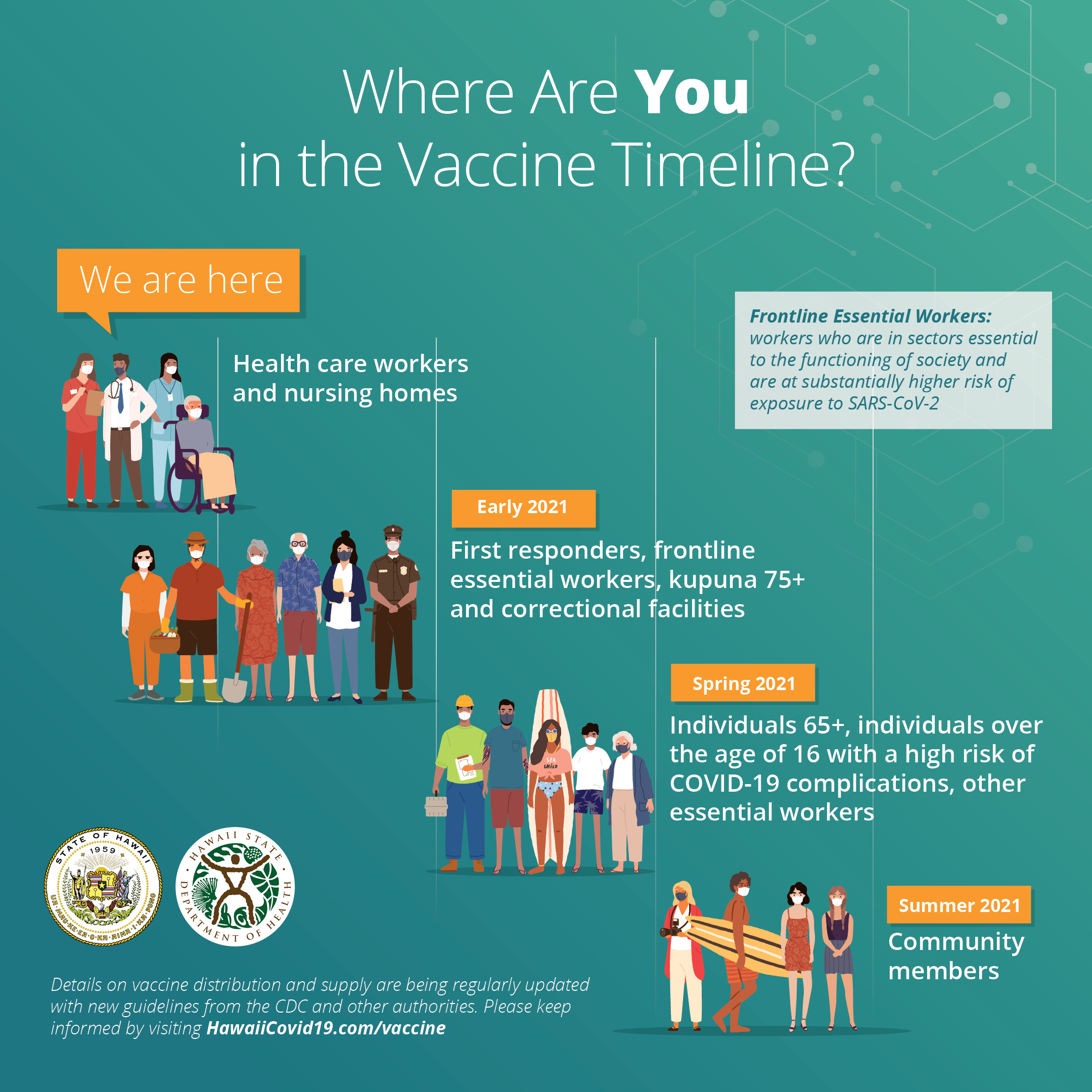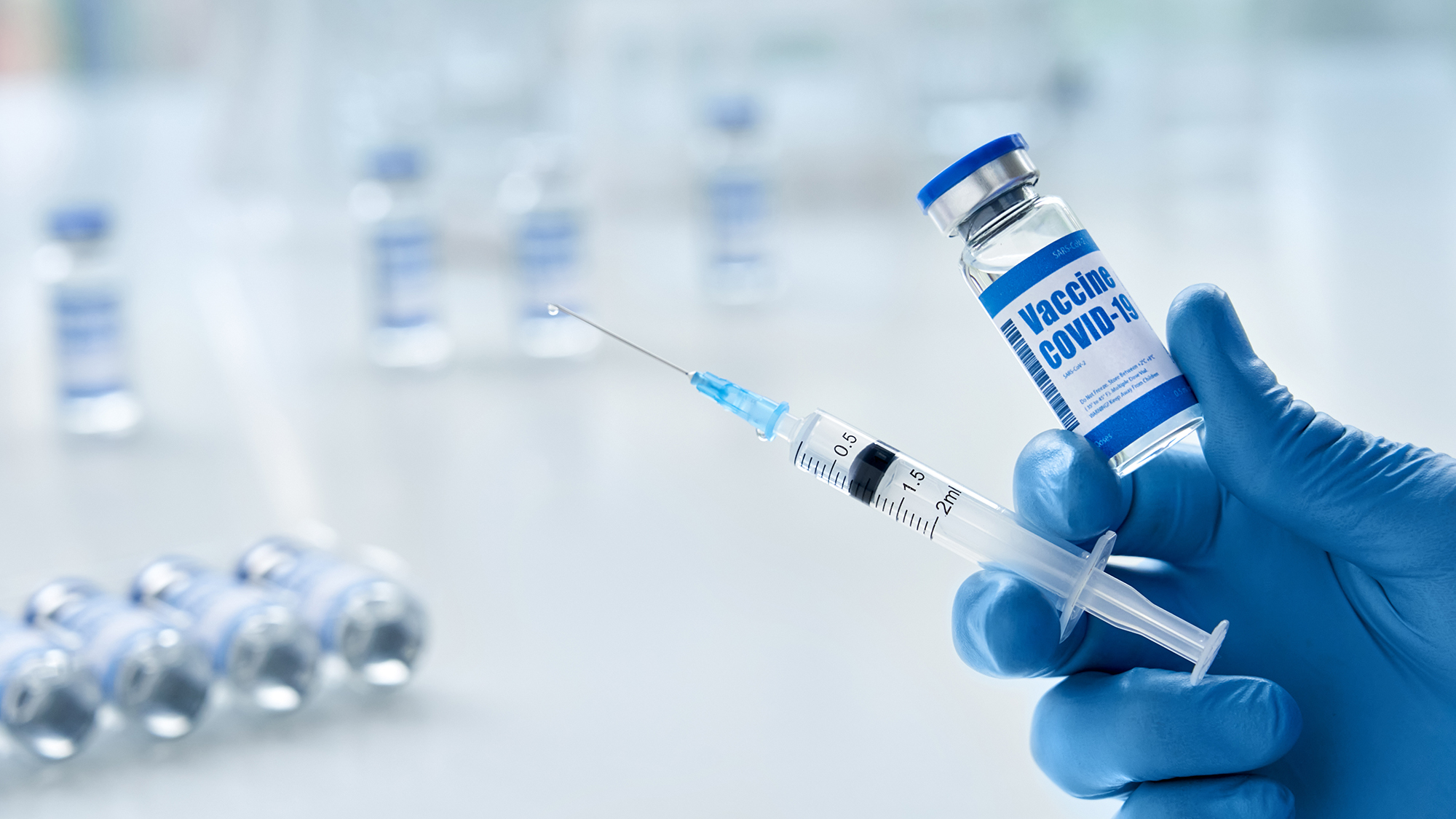Hawaii educators began receiving COVID-19 vaccines in January. HSTA has been in discussions with the Hawaii State Department of Education (HIDOE) and Department of Health (DOH). This post serves as a general overview for our members on vaccine access and distribution.
The COVID-19 vaccines began arriving in Hawaii in December. There are two phases to the vaccine distribution. Phase 1 is further broken down into three groups:
- 1a: Health care personnel and long-term care facility residents
- 1b: Adults older than 75 and frontline essential workers* ⬅️ Teachers fall in this category.
- 1c: Adults 65–74 years, persons 16–64 who have high-risk medical conditions, and essential workers who are not considered “frontline”
*Frontline essential workers are defined as workers whose duties must be performed on-site and require being in close proximity to the public or coworkers, are at substantially higher risk of exposure to SARS-CoV-2 and are essential to the functioning of society with special attention to life and safety first.
Approximately 75 percent of Hawaii’s population falls in category 1a, 1b, or 1c. This means that the Phase 1 vaccine distribution will likely continue through the spring and into the summer as the category includes approximately 800,000 people. Phase 2 includes everyone else ages 16 and older, around 300,000 people.
Vaccines have not been approved for distribution to anyone under 16 years old. The state has not given any indications that it will mandate vaccines for any student at this time. In addition, there are no plans to distribute vaccines to students ages 16+ through the public school system. Any determination of mandatory student vaccines would be led by the DOH, which has the authority to determine any required vaccines for students in public schools and universities.
Vaccine distribution and access are prioritized as illustrated below:

Make sure you notify your employer (HIDOE, charter school) if you want the vaccine
The HIDOE is developing a vaccination plan for all employees and service providers serving and supporting HIDOE schools.
To help expedite the administration process, the HIDOE opened an online survey to ask if employees are interested in receiving the vaccine. The survey also asks for personal contact information so officials can track and ensure recipients get their second dose in a timely manner.
Teachers are strongly encouraged to respond to the survey in a timely manner as submissions are provided to the DOH on a rolling basis.
Employees can expect to receive further information on opportunities to schedule their vaccines as they become available. This may include direct scheduling with either DOH, a regional health care provider, or a HIDOE partner site. Please keep in mind that timing will vary for all employees.
The HIDOE has split its employees into three groups to prioritize vaccinations:
- Group 1: Adults who work on-site and have direct contact with the public, including employees at the school level,
- Group 2: Those who work in close proximity to colleagues, including places like the district office staff, and
- Group 3: All others, including places like HIDOE state office.
Schools are also going to begin surveying employees on their desire to receive the vaccine. These surveys will not be distributed en masse; they are being coordinated locally through the district offices.
If you are at all interested in the vaccine, responding in the positive will ensure you are placed in the count. If you respond in the negative and change your mind later, this may delay your access to the vaccine, as vaccines are being ordered based on initial positive responses.
Each public charter school is coordinating distribution for its employees. If you have any questions regarding vaccine distribution for your school, please contact your adminstration.
HSTA encourages members, public to get vaccinated
While the state of Hawaii currently has no plans to mandate vaccines for employees in public schools, the HSTA fully encourages all of its members and the community to get COVID-19 vaccinations. HSTA is optimistic that when educators receive the second of the two-step vaccinations currently available in the United States, that will open up safer opportunities to increase in-person learning options. HSTA also believes teachers who are medically unable to receive the vaccine must also be given a chance to conduct distance learning until we have achieved herd immunity.
For the vaccine to be fully effective within our community, the goal is to vaccinate 60–70 percent of Hawaii’s 1.1 million population. The goal is to complete distributing the vaccine as quickly and effectively as possible, so distribution may ebb and flow at various rates based on the availability of vaccines within the immediate geographic area. For example, Kauai had additional vaccines available and the DOH made those available to HIDOE employees starting Jan. 11. This was very unusual, but a good example of how working quickly to provide vaccines to each priority group will result in inconsistent dates for distribution. Generally, the HSTA expects educators to receive access to the vaccines on a regular basis toward the end of January and early February.
How will I know when I can get the vaccine and if it’s available?
Once it is clear that vaccines are available for a specific employee group in a geographic area, you will be notified by your employer of the date, time, location, and any other specifics.
The HSTA has requested that, if possible, distribution sites be set up near workplaces. However, members should know the vaccines require specific cold storage and health care workers are in short supply, so all distribution of vaccines are being done in the most efficient way possible to maintain vaccine integrity and not overextend health care staff.
After HSTA advocated for its members to receive paid time to get their COVID-19 vaccines, School Superintendent Christina Kishimoto sent a memo authorizing up to two hours during the work day to Hawaii State Department of Education employees. View more information, including the full memo, here. Please note, charter school employees should consult their admin.
- Related Story: HIDOE allows employees up to 2 hours off to get vaccine
Note any history of allergic reactions and consult your doctor
If you visit a Department of Health COVID-19 vaccination point of dispensing (POD), e.g., Pier 2 and the Neal S. Blaisdell Center on Oahu, you will be asked to fill out a screening/assent form that includes the following questions:
- Have you ever had a severe allergic reaction (e.g., anaphylaxis) OR an immediate allergic reaction of any severity (e.g., itching, hives, flushing, difficulty breathing) to a previous dose of a COVID-19 vaccine, any of its components, or any injectable medication or therapeutic?
- Have you ever had an allergic reaction of any severity to any non-injectable medication, food, pet, insect, venom, latex, or environmental trigger?
Due to DOH policy, if you answer “yes” to the first question, you CANNOT receive the vaccine on site. If you answer “yes” to the second question, you will be monitored for 30 minutes after receiving the vaccine (recipients are typically monitored for 15 minutes).
If you fall into either of these categories, HSTA strongly recommends that you take the above into consideration and consult with your primary care physician before signing up to receive a vaccine at a POD. You may be advised to seek out options to receive your vaccine at a medical facility.
Here’s what to expect when you visit a DOH vaccination POD:
Click here to watch this video on YouTube.
The HSTA has representatives who sit on the state’s Vaccine Implementation Program Committee, which is made up of representatives from more than 100 medical organizations, government departments, schools, universities, and other non-profits throughout the state and community. Regular meetings and communications have occurred since November to keep all these groups informed. In addition, HSTA has been in discussion with the HIDOE regarding their plans for supporting vaccine availability for employees.
Using guidance from the federal government, the state developed a vaccine implementation plan that is in continuous adjustment and improvement.
Click here for more information related to the state’s vaccine program

